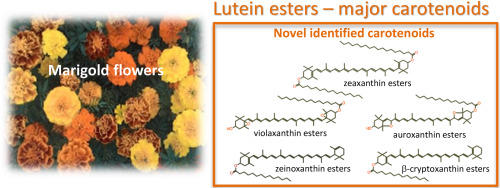当前位置:
X-MOL 学术
›
Food Res. Int.
›
论文详情
Our official English website, www.x-mol.net, welcomes your feedback! (Note: you will need to create a separate account there.)
Marigold carotenoids: Much more than lutein esters.
Food Research International ( IF 8.1 ) Pub Date : 2018-10-12 , DOI: 10.1016/j.foodres.2018.10.043 Daniele Bobrowski Rodrigues 1 , Adriana Zerlotti Mercadante 1 , Lilian Regina Barros Mariutti 2
Food Research International ( IF 8.1 ) Pub Date : 2018-10-12 , DOI: 10.1016/j.foodres.2018.10.043 Daniele Bobrowski Rodrigues 1 , Adriana Zerlotti Mercadante 1 , Lilian Regina Barros Mariutti 2
Affiliation

|
Carotenoids constitute a large group of lipophilic pigments whose health-promoting benefits have been widely recognized. Hydroxy-containing carotenoids can be found in both free form or esterified with fatty acids in several plant matrices, but the native carotenoid profile is overall poorly explored due to the difficulty of analyzing carotenoid esters. One of the main natural sources of carotenoids is the marigold flower, which has been extensively used by the industry for the production of food colorants or supplements, both often manufactured with no saponification process. Although lutein esters are well established as the major compounds naturally found in marigold petals and their products, carotenoid esters other than the lutein ones have not been extensively examined. We carried out a comprehensive identification of carotenoids and carotenoid esters from marigold petals by LC-DAD-(APCI+)MS/MS. Whereas 18 carotenoids were identified in the saponified extract, 56 were identified when no saponification procedure was carried out: 6 free carotenoids, 20 monoesters and 30 diesters. This is the first time that esters of zeaxanthin, violaxanthin, auroxanthin, zeinoxanthin and β-cryptoxanthin are identified in marigold. The structural information obtained through characteristic fragmentation patterns and diagnostic fragments in MS and MS/MS spectra (APCI+) sustained the differentiation between carotenoid esters with similar characteristics. Therefore, the separation of carotenoids by reversed-phase liquid chromatography using C30 columns in combination with DAD and APCI-MS/MS detection allowed high sensitivity and selectivity for carotenoid ester analysis.
中文翻译:

万寿菊类胡萝卜素:比叶黄素酯要多得多。
类胡萝卜素构成了一大群亲脂性颜料,其促健康益处已被广泛认可。含羟基的类胡萝卜素可以在多种植物基质中以游离形式存在或被脂肪酸酯化,但是由于难以分析类胡萝卜素酯,因此总体上对天然类胡萝卜素的概况研究甚少。类胡萝卜素的主要天然来源之一是万寿菊花,该花已被工业广泛用于生产食品着色剂或补品,通常都无需皂化工艺即可生产。尽管叶黄素酯已被确立为万寿菊花瓣及其产品中天然存在的主要化合物,但除叶黄素以外的类胡萝卜素酯尚未得到广泛研究。我们通过LC-DAD-(APCI +)MS / MS对万寿菊花瓣中的类胡萝卜素和类胡萝卜素酯进行了全面鉴定。皂化提取物中鉴定出18种类胡萝卜素,而未进行皂化步骤则鉴定出56种:6种游离类胡萝卜素,20种单酯和30种二酯。这是万寿菊中首次鉴定玉米黄质,紫黄质,金氧黄质,玉米黄质和β-隐黄质的酯。通过MS和MS / MS光谱(APCI +)中的特征性片段化模式和诊断性片段获得的结构信息维持了具有相似特征的类胡萝卜素酯之间的区分。所以,
更新日期:2018-10-12
中文翻译:

万寿菊类胡萝卜素:比叶黄素酯要多得多。
类胡萝卜素构成了一大群亲脂性颜料,其促健康益处已被广泛认可。含羟基的类胡萝卜素可以在多种植物基质中以游离形式存在或被脂肪酸酯化,但是由于难以分析类胡萝卜素酯,因此总体上对天然类胡萝卜素的概况研究甚少。类胡萝卜素的主要天然来源之一是万寿菊花,该花已被工业广泛用于生产食品着色剂或补品,通常都无需皂化工艺即可生产。尽管叶黄素酯已被确立为万寿菊花瓣及其产品中天然存在的主要化合物,但除叶黄素以外的类胡萝卜素酯尚未得到广泛研究。我们通过LC-DAD-(APCI +)MS / MS对万寿菊花瓣中的类胡萝卜素和类胡萝卜素酯进行了全面鉴定。皂化提取物中鉴定出18种类胡萝卜素,而未进行皂化步骤则鉴定出56种:6种游离类胡萝卜素,20种单酯和30种二酯。这是万寿菊中首次鉴定玉米黄质,紫黄质,金氧黄质,玉米黄质和β-隐黄质的酯。通过MS和MS / MS光谱(APCI +)中的特征性片段化模式和诊断性片段获得的结构信息维持了具有相似特征的类胡萝卜素酯之间的区分。所以,



























 京公网安备 11010802027423号
京公网安备 11010802027423号